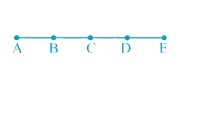Let A, B, C, D be points on a vertical line such that AB = BC = CD. If a body is released from position A, the times of descent through AB, BC and CD are in the ratio.
1:√3−√2:√3+√2
1:√2−1:√3−√2
1:√2−1:√3
1:√2:√3−1
To solve the problem, we need to analyze the motion of a body falling under gravity from point A to points B, C, and D, where the distances AB, BC, and CD are equal.
Let's denote the distance between each pair of points (AB, BC, CD) as h. Thus, we have:
- Distance AB=h
- Distance BC=h
- Distance CD=h
Now, we will calculate the time taken to fall through each segment using the equations of motion under uniform acceleration due to gravity.
Step 1: Time of descent through AB
Using the second equation of motion:
s=ut+12at2
where:
- s is the distance fallen (which is h for segment AB),
- u is the initial velocity (which is 0 since the body is released),
- a is the acceleration due to gravity (denoted as g),
- t is the time taken to fall through the distance s.
For the segment AB:
h=0⋅t1+12gt21
This simplifies to:
h=12gt21
Rearranging gives:
t21=2hg
Taking the square root:
t1=√2hg
Step 2: Time of descent through BC
For the segment BC, the body has already fallen a distance h (from A to B), so the total distance fallen from A to C is 2h. Thus, we can use the same equation of motion:
2h=0⋅t2+12gt22
This simplifies to:
2h=12gt22
Rearranging gives:
t22=4hg
Taking the square root:
t2=√4hg=2√hg
Step 3: Time of descent through CD
For the segment CD, the body has fallen a total distance of 3h:
3h=0⋅t3+12gt23
This simplifies to:
3h=12gt23
Rearranging gives:
t23=6hg
Taking the square root:
t3=√6hg=√6√hg
Step 4: Finding the ratio of times
Now we have the times:
- t1=√2hg
- t2=2√hg
- t3=√6√hg
To find the ratio t1:t2:t3:
t1:t2:t3=√2hg:2√hg:√6√hg
Dividing each term by √hg:
t1:t2:t3=√2:2:√6
Step 5: Final Ratio
To express this in a more standard form, we can multiply each term by a common factor to eliminate the square roots. The least common multiple of the denominators can be used. However, the simplest ratio remains:
t1:t2:t3=√2:2:√6
- Distance BC=h
- Distance CD=h
Using the second equation of motion:
s=ut+12at2
where:
- s is the distance fallen (which is h for segment AB),
- u is the initial velocity (which is 0 since the body is released),
- a is the acceleration due to gravity (denoted as g),
- t is the time taken to fall through the distance s.
h=0⋅t1+12gt21
This simplifies to:
h=12gt21
Rearranging gives:
t21=2hg
Taking the square root:
t1=√2hg
For the segment BC, the body has already fallen a distance h (from A to B), so the total distance fallen from A to C is 2h. Thus, we can use the same equation of motion:
2h=0⋅t2+12gt22
This simplifies to:
2h=12gt22
Rearranging gives:
t22=4hg
Taking the square root:
t2=√4hg=2√hg
For the segment CD, the body has fallen a total distance of 3h:
3h=0⋅t3+12gt23
This simplifies to:
3h=12gt23
Rearranging gives:
t23=6hg
Taking the square root:
t3=√6hg=√6√hg
Now we have the times:
- t1=√2hg
- t2=2√hg
- t3=√6√hg
t1:t2:t3=√2hg:2√hg:√6√hg
t1:t2:t3=√2:2:√6
To express this in a more standard form, we can multiply each term by a common factor to eliminate the square roots. The least common multiple of the denominators can be used. However, the simplest ratio remains:
t1:t2:t3=√2:2:√6
Topper's Solved these Questions
Similar Questions
Knowledge Check
If A, B, C and D are four numbers such that A:B=2:3,B:C=4:5,C:D=5:8, then A:D is equal to
A1:3B3:1C2:3D3:2If AB =112cm, BC=16 cm and AB is perpendicular to BC, then the radius of the circle passing through the points A, B and C is
A90∘B120∘C60∘D150∘Let D be the mid-point of a straight line AB and let C be a point different from D such that AC=BC, then.
AAC⊥ABB∠BDC=90∘C∠BDC is acuteD∠BNDC>90∘
In Fig. 2.15, points A,B,C,D and E are collinear such that AB = BC = CD= DE. Then

AE = ________ × AB.
View SolutionIn Fig. 2.15, points A,B,C,D and E are collinear such that AB = BC = CD= DE. Then

AD = AB + ________
View SolutionIn Fig. 2.15, points A,B,C,D and E are collinear such that AB = BC = CD= DE. Then

AD = AC + ___________
View SolutionLet D be the mid-point of a straight line AB and let C be a point different from D such that AC=BC, then.
View SolutionAb Bc Cd De Ef Fg G?
View Solution

